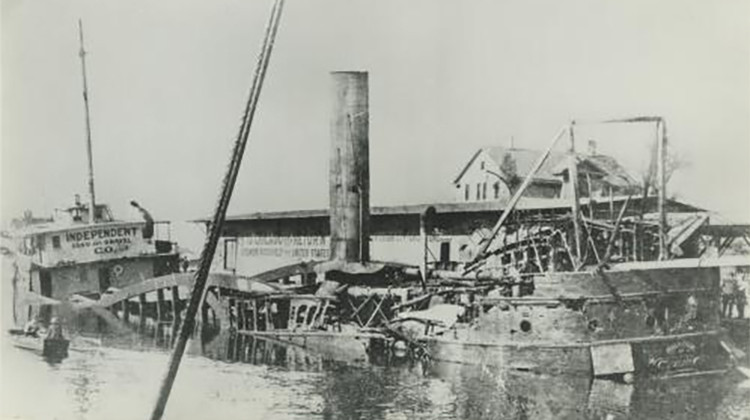
This photo from 1910 shows the wreck of the steamer Muskegon.
Alpena County George N. Fletcher Public Library/public domainJOSEPH S. PETE - The Times
MICHIGAN CITY, Ind. (AP) — More than a century ago, townspeople wearied of looking at the fire-torched hull of the SS Muskegon, which had been abandoned in the Michigan City marina.
So they dragged it out into Lake Michigan and sank it.
Now the shipwreck of the 211-foot freighter that sank near Mount Baldy in Michigan City in 1911 could become Indiana’s second underwater preserve.
Indiana University’s Center for Underwater Science is leading a charge to create the preserve about 2.8 miles from the Mount Baldy beach at a depth of about 30 feet. It would follow the J.D. Marshall Preserve, just off the shore at the Indiana Dunes State Park, that commemorates the capsized ship and four crew members whose history is on display at the state park’s Nature Center and Michigan City’s Old Lighthouse Museum.
The preserve designation would mark the site with buoys and protect it for scuba diving and exploration. It would establish boundaries for boats, likely lead to interpretative signs along the shore and provide the public with virtual tours.
Divers can see the ship’s frame, propeller, driveshaft, steam engine and twin boilers in their watery final resting place under Lake Michigan.
IU Center for Underwater Science Director Charles Beeker submitted the nomination to the Indiana Department of Natural Resources. Beeker, a diver who also helped establish the J.D. Marshall Preserve, had been working on the preserve designation on and off since 2000 before it was fast-tracked after the coronavirus pandemic hit last year.
“I’ve had meetings with the Indiana DNR and it’s moving forward,” he said. “The state accepted the nomination. We’re now working on the details and soliciting local support. We’re pleased the state has taken our recommendation.”
Divers discovered the shipwreck in the 1960s. Now listed on the National Register of Historic Places, it’s one of 50 shipwrecks off the Indiana coast and 6,000 in the Great Lakes, Beeker said.
“This leads to people going out in boats and tourism,” he said. “It’s a special level of enhancement that will result in a historical marker, buoys, interesting materials and a meaningful experience diving there.”
The SS Muskegon was a 1,199 gross ton freighter also known at one point as the Peerless under different ownership. At different points in its lifespan, it ferried passengers, hauled freight, sucked up sand from the bottom of Lake Michigan and was suspected at one point to be a floating host for gambling.
“For its first 25 years, it was one of the finest ships carrying freight on the Great Lakes,” Beeker said. “It was a vessel with no equal at its time.”
It’s not feasible to see the shipwreck via snorkeling, as the water is not very clear at that depth. But it’s easy to reach via boat or kayak.
“It’s the same thing as the J.D. Marshall, which is about 400 yards offshore,” he said. “It makes it easy to appreciate. You have other Great Lakes shipwrecks 100 feet down where little is exposed. This is a fun dive, not a hardcore dive.”
Even for those who don’t dive, the nature preserve will help raise awareness about the boat’s history.
“Not many have been to the Titanic shipwreck site,” Beeker said.
First launched in 1872, the SS Muskegon was a single-propeller passenger ferryboat on the Great Lakes. It carried freight mail and later gathered sand that was used as a building and manufacturing material as it got older and was eclipsed with newer ships.
Built in Ohio, it often visited ports in Chicago, Duluth and Grand Haven. Its full history before it caught fire, burned at the dock and was sunk is not fully known.
“Ernest Hemingway traveled on vessels like that on the Great Lakes from when he was a young kid to 12 years old,” Beeker said. “It’s possible he might have traveled on it.”
The ship did have a major economic impact on Lake Michigan in the 19th century.
“We’re pleased the state recognized the value of shipwrecks and the maritime landscape as a whole on the Great Lakes,” he said. “The maritime industry made the state what it is today. It was a ferryboat for 25 years and a prized vessel to get on in Chicago and ports along the way. It’s our history.”
Such shipwrecks were often scavenged in the past, but are now being preserved.
“They were looted but are much better protected now,” he said. “There’s an inventory of the artifacts that are part of the shipwreck. Making it a preserve ensures it remains accessible to the public while people take only photos and leave only bubbles.”
Jim Retseck, president of the Michigan City Historical Society, said the state’s second underwater nature preserve would commemorate an important history.
“At one time it was a passenger ship that became a sandsucker when it grew long in the tooth,” he said. “It was docked right at the back of the Old Lighthouse before it caught on fire. There was a night watchman on it, which makes it kind of odd. But it had kerosene lamps and was made of wood so it was flammable. We do also have the possibility it was struck by lightning. But there was a watchman so you think they would have caught it sooner. Pretty much everything burned out while it was anchored there.”
The shipwreck, however, has maintained much of its integrity while at its watery grave at the bottom of Lake Michigan.
“It’s in excellent condition, which is a rather unusual situation,” Retseck said. “The freshwater, cold water in the winter and sandy bottom all aid in the preservation. A few things have gone missing from it, but federal and state law now prevent people from bringing things up off these ships.”
It shares an intertwined history with the J.D. Marshall, which was a lumber hauler that became a sandsucker owned by the same company. The J.D. Marshall sank a day after the SS Muskegon’s sandsucking equipment was installed on it.
“The first mate and three crew members died on that ship,” he said. “The Muskegon had no fatalities. What it did was suck up sand and sell it. It’s just ironic they ended up having the same fate.”
The state nature preserve status raised the profile of the JD Marshall, Beeker said.
“It’s appreciated in the Nature Center and with hikes to see the buoys and interpretive materials,” he said. “The state has a website and we’ve been developing more materials. It’s increased interest, bringing visitors from as far as California at a time when domestic travel is on the rise.”
He’s working with the state to plan a big public event when the SS Muskegon gets inaugurated as a state nature preserve just off the shore in the Indiana Dunes National Park.
“We’ve talked about a similar type of event as we had with the J.D. Marshall,” he said. “We want to get the public involved to celebrate the maritime heritage. Shipwrecks are finite. This is a submerged cultural resource. The days of looting shipwrecks are over.”
Source: The Times
 DONATE
DONATE






 Support WFYI. We can't do it without you.
Support WFYI. We can't do it without you.